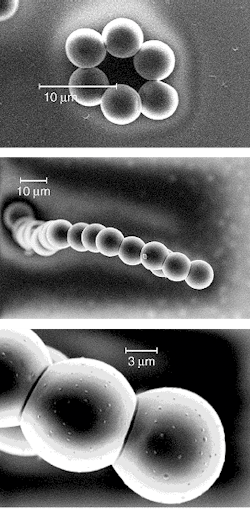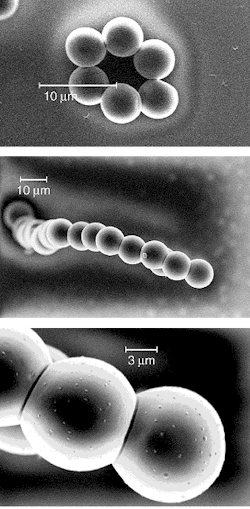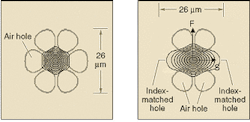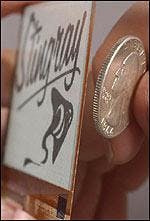Newsbreaks
Researchers from the University of St. Andrews (Fife, Scotland) and from the Ioffe Physico-Technical Institute (St. Petersburg, Russia) reported amplification in excess of 21 dB for femtosecond pulses in a quantum-dot semiconductor optical amplifier (SOA). According to a postdeadline presentation at the recent Conference on Lasers and Electro-Optics (CLEO; Long Beach, CA), the experiments were made over a range of pump pulse energies from 0.01 to 3 pJ and pump-signal wavelengths from 1160 to 1400 nm.
The pump consisted of a periodically poled, lithium niobate-based optical parametric oscillator (OPO) operating at about 200 fs and 84 MHz that was coupled into the waveguide of the SOA through a high-numerical-aperture lens. The active laser region in the quantum-dot structure, grown on an n+ gallium arsenide (GaAs) substrate by molecular-beam epitaxy, consisted of three planes of self-organized quantum dots separated by GaAs spacers and was located in the center of a 0.35-μm waveguide layer consisting of a short-period aluminum gallium arsenide/gallium arsenide superlattice. At a forward bias current of 155 mA, maximum pulse amplification on the order of 21 dB was achieved near the 1250-nm spontaneous-emission peak of the quantum-dot device, with a bandwidth on the order of 100 nm (about 14 dB at 1175 nm and 16 dB at 1275 nm). Contact Edik Rafailov at [email protected].
ZnS and ZnSe microchip lasers emit continuous-wave infrared radiationProducing another entry in the mid-infrared-laser category for remote sensing, researchers at the University of Alabama (Birmingham, AL) and Kuban State University (Krasnodar, Russia) have developed erbium-fiber-laser-pumped microchip lasers based on high-quality chromium-doped zinc sulfide (ZnS) and zinc selenide (ZnSe) crystals, which are fabricated by chemical transport reaction from the gas phase and doped by a diffusion method. The microchip configuration permits compact and low-cost lasers.
Both types of crystals were formed into cavities with millimeter-scale lengths, with versions constructed with either hemispherical or parallel cavities. The lasers were pumped with a 2-W single-mode continuous-wave fiber laser emitting at 1550 nm. The ZnS- and ZnSe-based microchip lasers emitted maximum optical output powers of 63 and 100 mW at 2320 and 2520 nm, respectively, with slope efficiencies of 53% and 20%. The temporal-mode structures of the lasers showed many modes extending over a spectral region of more than 50 nm, with approximately 100 modes for ZnSe and 50 for ZnS. Coupled with an external etalon, the lasers emitted 25 to 35 modes. Contact Sergey Mirov at [email protected].
Polymer microspheres make a photonic wireA new type of stable photonic-wire structure has been generated by chemists at Oak Ridge National Laboratory (Oak Ridge, TN) that may lead to applications in three-dimensional (3-D) conductive vertical wires and supports, sensors, and microphotonics. The polymer photonic wires consisted of an arbitrary number of intersecting polymer-blend microparticles strung together. A 25-cm-long linear quadrupole driven at 400 Hz and 650 V was used as a particle-focusing tool to manipulate the particles into 2- or 3-D architectures such as the ones shown. For the 2-D structures, an x-y translation stage underneath the quadrupole axis positioned particles according to the direction of scattering.
The optical properties of the linked particle systems were examined using an f-matched spectrograph coupled to the side port of an inverted microscope. At specific points on the sphere chain, a 514.5-nm-emitting continuous-wave argon-ion laser with a spot diameter of 1 μm caused fluorescence. Optical resonances occurred near the intersection between spheres. Ray traces show coupled resonant modes propagate at an angle near the half-angle of intersection, suggesting that a variety of 2- and 3-D photonic-wire structures can be tailored to specific applications. Contact Michael D. Barnes at [email protected].
Negative-differential-resistance device responds to lightPerhaps hastening the day of practical high-speed silicon (Si)-based monolithic optoelectronic integrated circuits, a group at IBM Microelectronics (Essex Junction, VT) has developed a light-controllable Si-based negative-differential-resistance (NDR) device that works at room temperature. Light detectors that exhibit NDR are fast and have intrinsic binary on-off characteristics. Such devices could be combined with Si-based light sources in development to integrate all active functions on one chip, or to sense external light sources.
Made in a deep-trench, nitride oxide, metal-insulator-semiconductor three-terminal configuration, the device was fabricated by a standard metal-oxide-semiconductor process and characterized under tungsten-lamp illumination. The NDR peak was repeatable, stable, and tunable by varying the well bias. Although the detector has characteristics of a high-speed device, no attempts were made to optimize this first prototype for high speed. Other potential uses for the device are in photosensing, optical analog-to-digital converters, optical frequency multipliers, laser radar and ranging, quantum devices, and parity generators for error detection in optical communication. Contact Fen Chen at [email protected].
Deep-ultraviolet coherent light shines from KBBF crystalThe Chinese Academy of Sciences (Beijing, China) reported obtaining coherent 179.4-nm emission from the fourth-harmonic generation of a nanosecond Ti:sapphire laser system. The system, which had an output of 717.4 nm and a repetition rate of 1 kHz, consisted of a Ti:sapphire oscillator pumped by a Nd:YLF laser and a Ti:sapphire amplifier pumped by a Nd:YLF laser. The light was directed through a 5-mm-thick, type I phase-matched lithium boron oxide (LBO) crystal, converting 10% of the fundamental wavelength into second-harmonic generation (SHG) at 358.7 nm. The remaining 400-mW light was focused into a 10 x 1.2-mm platelike crystal of potassium diberyllium boron trioxide fluoride (KBe2BO3F2 or KBBF) using 60° prisms. One interface of the KBBF crystal was filled with silicone oil, and the other was filled with Fomblin (perfluoropolyether). The fundamental (717.4-nm), SHG (358.7-nm), and fourth-harmonic (179.4-nm) wavelengths had corresponding pulse durations of 21, 15, and 13 ns. Output power of 8 to 2 mW was obtained in the wavelength region of 200 to 186.3 nm, showing promise for detailed inspection of optics, photolithography, and laser micromachining. ontact Chuangtian Chen at [email protected].
Microstructured fiber shows tunable birefringenceResearchers at OFS Fitel Laboratories (Somerset, NJ) have demonstrated tunable birefringence in a microstructured silica fiber with some of its air holes filled with a polymer. The geometrysix holes equally spaced around a central solid coreis not normally birefringent, but when, for example, two opposing air holes are filled with an acrylate-based polymer with a refractive index that varies with temperature (dN/dT of -4 x 10-4/°C), temperature-tunable birefringence appears (nx - ny is on the order of 10-3) at a tapered section of the fiber. Varying the temperature over a 140°C range changes the birefringence over a range of approximately 4.4 x 10-4.
To fill the air holes with polymer, the researchers immerse one end of the fiber in a fluid monomer blend, sealing specific air holes, and apply a vacuum to the other end of the fiber. The monomer is then cured with ultraviolet radiation to form a polymer. A capillary heater provides fast 1-s-scale temperature tuning, producing a relative phase shift of 6π over the fiber length and a tuning coefficient of 15 rad/m°C. Contact Benjamin Eggleton at [email protected].
Timing-jitter compensator opens eye closureResearchers at Lucent Technologies (Holmdel, NJ) have demonstrated a time-lens timing-jitter compensator to improve bit-error rates in ultralong-haul dense wavelength-division-multiplexing (DWDM) soliton transmissions. The device, described in a postdeadline presentation at the annual Conference on Lasers and Electro-Optics (CLEO; Long Beach, CA) in May, consisted of two lithium niobate phase modulators rendered polarizationindependent by a polarization-diversity scheme and followed by a linear dispersive element (1 km of dispersion-compensating fiber).
Using the phase-modulator stage to frequency-shift input pulses in proportion to jitter placement and the dispersive element to translate each pulse on to the mean arrival time, the device successfully removed eye closure and reduced the timing-jitter penalty in a DWDM, all-Raman-amplified, dispersion-managed soliton system consisting of about 100 10-Gbit/s wavelength channels with 50-GHz spacing. Error-free distances of 5500 km were improved to about 7500 km using the timing-jitter compensator for an improvement in Q factors, based on the measured bit-error rate, of about 2.1 dB at 7200 km. According to the researchers, the design of their device is also independent of transmission distance. Contact Chris Xu at [email protected].
Foil-based 0.3-mm-thick active-matrix display targets handheld devicesActive-matrix flat-panel displays are normally fabricated on glass, a relatively inert substance amenable to semiconductor processing. But glass displays are fragilea problem for portable devices such as cell phones, which get dropped all too often. Ongoing research aims to replace glass with something more durable: for example, plastic combined with organic transistors. Such displays, however, may be years away from fruition. Avoiding the esoteric-materials problem, engineers at E Ink (Cambridge, MA) have developed an active-matrix display consisting of E Ink's electrophoretic-ink technology on a steel-foil substrate, for a total display thickness of only 0.3 mm. Steel foil is inexpensive, durable, and allows for standard semiconductor processing techniques.
One display prototype, targeted for handheld devices, has a 96-pixel-per-in. resolution, a 3-in. diagonal, and a size of 240 x 160 pixels. Another display with a 1.6-in. diagonal can be integrated into so-called "smart cards"a feat impossible for ordinary active-matrix displays. The bendability of the foil-based displays will enable designers to incorporate curved display surfaces into portable devices. The displays are expected to reach consumers in 2004 to 2005. See www.eink.com.
Photonic-crystal fiber guides terahertz pulsesThe field of terahertz imaging is inhibited by the lack of low-loss waveguides for convenient delivery of terahertz radiation. Now, a group at the Pohang University of Science and Technology (Pohang, Korea) has created plastic photonic-crystal fibers that guide terahertz pulses in single-mode fashion over the 0.1- to 3-THz frequency range. The fibers are fabricated from 500-μm-diameter high-density polyethylene (HDPE) tubes formed into a hexagonal lattice with a single solid HDPE rod at its center to form a high-refractive-index lattice defect. With a tube-wall thickness of 50 μm, the lattice has an air-fill factor of 0.673.
Terahertz pulses of approximately 0.8-ps duration (full width at half maximum) were generated by an optical rectification method using a semi-insulating gallium arsenide substrate. The detector was a photoconductive antenna. Two off-axis parabolic mirrors and two hyperhemispherical silicon lenses coupled the radiation into and out of the fiber, which was 2 cm long. At more than 0.4 THz, the insertion loss of the fiber was less than 5 dB. Dispersion depended on wavelength, with a zero-group-velocity-dispersion point existing at 0.5 THz. Contact Hae-Wook Han at [email protected].



